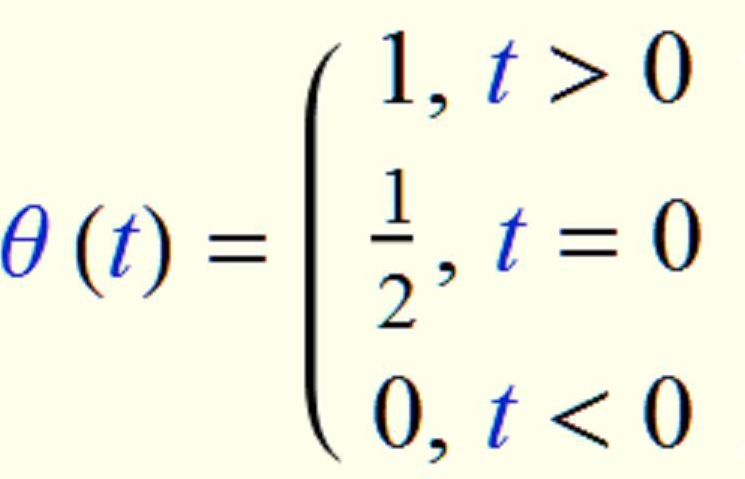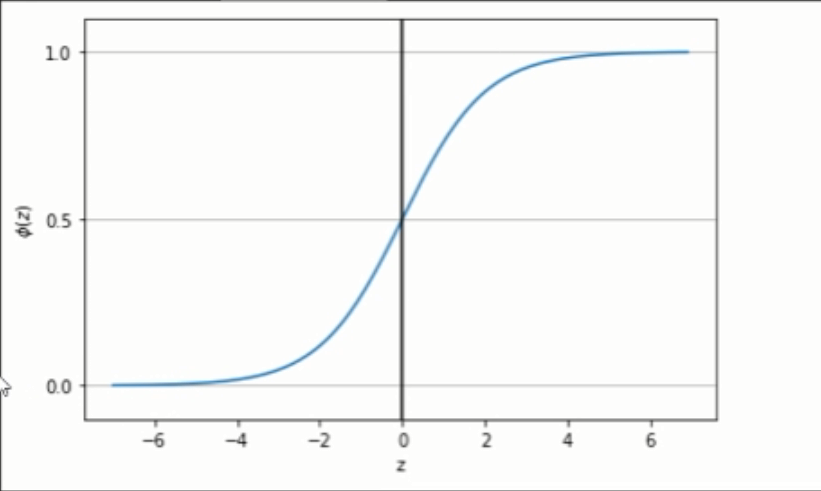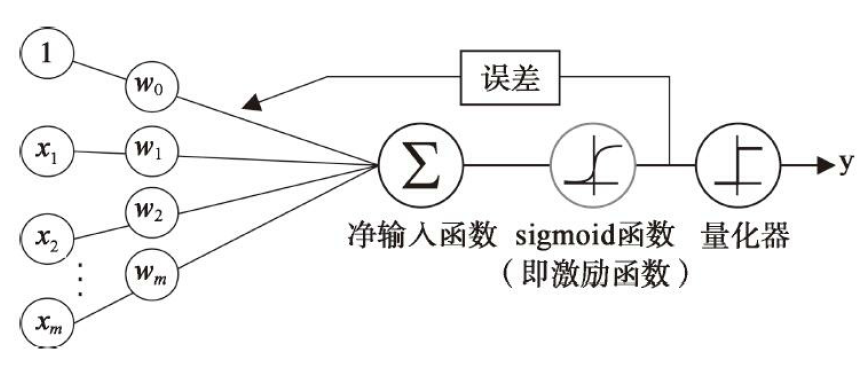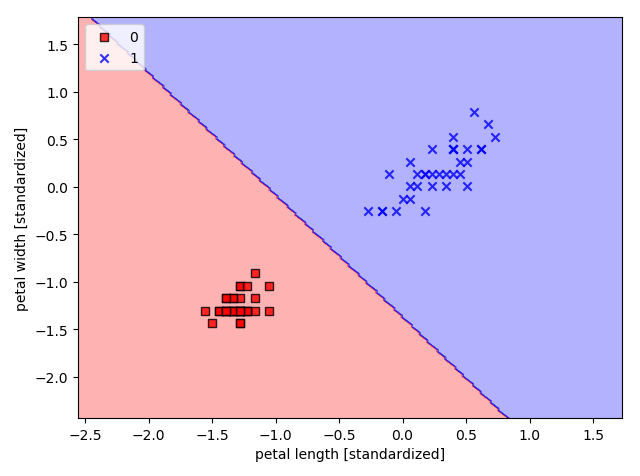线性模型之四:逻辑回归
一、问题描述
前面我们讨论了使用线性模型进行回归学习,但是要做分类任务怎么办?只需要找一个单调可微函数将任务分类的真实标记 y 与线性回归模型的预测值联系起来。
考虑二分类任务,其输出应该是 y 属于[0, 1]。而线性回归模型产生的预测值 z = wx+b是实值。于是我们考虑将 z 转换到 0 / 1值。
二、对数几率回归
最理想的将实值转换为[0, 1]区间的是单位阶跃函数。

但是这个函数不连续,所以要考虑其他的函数。
先介绍一下几率回归。它指的是特定事件发生的几率。用数学公式: p/(1-p)
其中p为正事件发生的概率,指的是我们关注事件发生的概率。更进一步,可以定义logit函数,对数几率,

logit函数输入范围介于区间[0, 1], 它能将输入转换到整个实数范围内。而我们之前考虑的函数映射将实值转换为[0, 1],所以考虑logit的反函数。
此处,p(y=1|x)是在给定特征x的条件下,某一个样本属于类别1的条件概率。它是logit函数的反函数,也称作logistic函数,也称为sigmoid函数。

这里,z 作为输入

sigmoid函数的图形


当s函数输入大于0时,s函数的输出大于0.5,反之则小于0.5。

sigmoid函数的输出值 p 介于[0, 1]之间,表示某个事件发生的概率。
三、代价函数
为了推导出逻辑回归的代价函数,需要先定义一个最大似然函数L

对于二分类问题,y只能有两个值1 和 0。
![]() 为s函数的输出值,用来表示概率的大小。如果y为1时,预测的概率值为
为s函数的输出值,用来表示概率的大小。如果y为1时,预测的概率值为![]() ,我们希望
,我们希望![]() 尽可能大。
尽可能大。
如果y为0,预测的概率值为![]() ,我们则希望
,我们则希望![]() 尽可能大。
尽可能大。
那么写成一个表达式,![]() 。我们希望这个表达式的值尽可能最大。
。我们希望这个表达式的值尽可能最大。
我们的目标是使用已知的N个样本,使得这个L的概率值最大。由于连乘不容易处理,可以使用取对数的方法,转化为连加。

对数似然函数可以更容易求导。然后加上负号,可以使用梯度下降算法求解函数的最小值了。

四、正则化

sklearn 库中,LogisticRegression类,参数C是正则化系数的倒数

代码示例:
LogisticRegressionGD.py
import numpy as np class LogisticRegressionGD(object): """Logistic Regression Classifier using gradient descent. Parameters ------------ eta : float Learning rate (between 0.0 and 1.0) n_iter : int Passes over the training dataset. random_state : int Random number generator seed for random weight initialization. Attributes ----------- w_ : 1d-array Weights after fitting. cost_ : list Sum-of-squares cost function value in each epoch. """ def __init__(self, eta=0.05, n_iter=100, random_state=1): self.eta = eta self.n_iter = n_iter self.random_state = random_state def fit(self, X, y): """ Fit training data. Parameters ---------- X : {array-like}, shape = [n_samples, n_features] Training vectors, where n_samples is the number of samples and n_features is the number of features. y : array-like, shape = [n_samples] Target values. Returns ------- self : object """ rgen = np.random.RandomState(self.random_state) self.w = rgen.normal(loc = 0.0, scale=0.01, size = 1+X.shape[1]) self.cost = [] for i in range(self.n_iter): output = self.activation(self.net_input(X)) error = y - output self.w[1:] = self.w[1:] + self.eta * X.T.dot(error) self.w[0] = self.w[0] + self.eta * np.sum(error) #each_cost = -np.sum((y * np.log(output)+(1-y) * np.log(1-output))) each_cost = -y.dot(np.log(output)) - (1-y).dot(np.log(1-output)) self.cost.append(each_cost) return self def net_input(self, X): """Calculate net input""" return np.dot(X, self.w[1:]) + self.w[0] def activation(self, z): """Compute logistic sigmoid activation""" return 1 / (1+ np.exp(-z)) def predict(self, X): """Return class label after unit step""" return np.where(self.net_input(X) >= 0, 1, 0) # equivalent to: # return np.where(self.activation(self.net_input(X)) >= 0.5, 1, 0)
testLogisticRegression.py
import matplotlib.pylab as plt import numpy as np from LogisticRegressionGD import LogisticRegressionGD from sklearn import datasets iris_data = datasets.load_iris() x = iris_data.data[:, [2, 3]] y = iris_data.target #print('Class Labels:', np.lib.arraysetops.unique(y)) from sklearn.model_selection import train_test_split X_train, X_test, y_train, y_test = train_test_split( x, y, test_size=0.3, random_state=1, stratify=y) #print('labels counts in y:', np.bincount(y)) #print('labels counts in y_train:', np.bincount(y_train)) #print('labels counts in y_test:', np.bincount(y_test)) from sklearn.preprocessing import StandardScaler sc = StandardScaler() sc.fit(X_train) X_train_std = sc.transform(X_train) X_test_std = sc.transform(X_test) # In[]: from matplotlib.colors import ListedColormap import matplotlib.pyplot as plt # 分类决策区域函数 # 注意,这个cell也必须run,把画图函数载入进来,否则后面无法调用 def plot_decision_regions(X, y, classifier, test_idx=None, resolution=0.02): # setup marker generator and color map markers = ('s', 'x', 'o', '^', 'v') colors = ('red', 'blue', 'lightgreen', 'gray', 'cyan') cmap = ListedColormap(colors[:len(np.unique(y))]) # plot the decision surface x1_min, x1_max = X[:, 0].min() - 1, X[:, 0].max() + 1 x2_min, x2_max = X[:, 1].min() - 1, X[:, 1].max() + 1 xx1, xx2 = np.meshgrid(np.arange(x1_min, x1_max, resolution), np.arange(x2_min, x2_max, resolution)) Z = classifier.predict(np.array([xx1.ravel(), xx2.ravel()]).T) Z = Z.reshape(xx1.shape) plt.contourf(xx1, xx2, Z, alpha=0.3, cmap=cmap) plt.xlim(xx1.min(), xx1.max()) plt.ylim(xx2.min(), xx2.max()) for idx, cl in enumerate(np.unique(y)): plt.scatter(x=X[y == cl, 0], y=X[y == cl, 1], alpha=0.8, c=colors[idx], marker=markers[idx], label=cl, edgecolor='black') # highlight test samples if test_idx: # plot all samples X_test, y_test = X[test_idx, :], y[test_idx] plt.scatter(X_test[:, 0], X_test[:, 1], c='', edgecolor='black', alpha=1.0, linewidth=1, marker='o', s=100, label='test set') X_train_01_subset = X_train_std[(y_train == 0) | (y_train == 1)] y_train_01_subset = y_train[(y_train == 0) | (y_train == 1)] lrgd = LogisticRegressionGD(eta=0.05, n_iter=1000, random_state=1) print(X_train_01_subset.shape) print(y_train_01_subset.shape) lrgd.fit(X_train_01_subset, y_train_01_subset) plot_decision_regions(X_train_01_subset, y_train_01_subset, classifier=lrgd) plt.xlabel('petal length [standardized]') plt.ylabel('petal width [standardized]') plt.legend(loc='upper left') plt.tight_layout() plt.show()
输出示例



